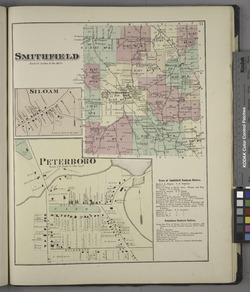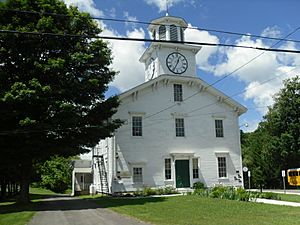Peterboro, New York facts for kids
Quick facts for kids
Peterboro, New York
|
|
|---|---|

1875 map
|
|
| Country | United States |
| State | New York |
| County | Madison |
| Town | Smithfield |
| Elevation | 1,296 ft (395 m) |
| Time zone | UTC-5 (Eastern (EST)) |
| • Summer (DST) | UTC-4 (EDT) |
| ZIP code |
13134
|
| Area code(s) | 315 & 680 |
| GNIS feature ID | 960231 |

Peterboro is a small, historic community called a hamlet in New York. It is located about 25 miles southeast of Syracuse, New York. Today, Peterboro is the main office for the Town of Smithfield in Madison County. It even has its own Post Office with ZIP code 13134.
Before the U.S. Civil War, Peterboro was a very important place for the abolition movement in the United States. Abolitionism was the movement to end slavery. Peterboro was home to a famous person named Gerrit Smith. He was a businessman, a generous giver, and a thinker who strongly believed in ending slavery.
Because of Gerrit Smith, Peterboro became a safe haven for people who had escaped slavery. It was known as a place where slave catchers (people who tried to capture escaped slaves) would not dare to go. The New York Anti-Slavery Society, a group working against slavery, could meet safely in Peterboro after being chased out of other cities.
Many famous abolitionist leaders visited Gerrit Smith's home in Peterboro. These included John Brown, Frederick Douglass, and Harriet Tubman. So many people escaping slavery came to Peterboro that a book was written about them. Some of these individuals even stayed in Peterboro, helping to form a Black community there very early on.
A minister visiting Peterboro in 1841 described it this way:
At Peterboro (the residence of Gerrit Smith), I found as may well be expected, it was all Abolition—Abolition in doors and out—Abolition in the churches and Abolition in the stores—Abolition in the field and Abolition by the wayside. If I should use a figure, I would say that Peterboro is Bible-baptized into Abolition, in the name of the Father, and of the Son, and of the Holy Ghost.
Another abolitionist, Julia Griffiths, said:
I always breathe more freely in Peterboro, than elsewhere. The moral atmosphere is so clear here...
This shows how Peterboro was a special place for those fighting against slavery.
In 1859, Peterboro had several businesses, including two drug stores and two grocery stores. It also had the Peterboro Academy, a school, and a hotel. The Presbyterian church, built in 1820, was later bought by Gerrit Smith. He used it as a school and a public hall. Today, this building houses the Town of Smithfield office and the National Abolition Hall of Fame and Museum. Gerrit Smith's large home was destroyed by fire in 1936. However, his office, called the Peterboro Land Office, still stands. There is also a Peterboro Area Museum in a former schoolhouse.
Contents
How Peterboro Began
Peterboro was founded in 1795 by Peter Smith Sr. He was a business partner of John Jacob Astor and made a lot of money in the fur trade. Peter Smith Sr. named the town "Peterborough" after himself. In 1804, he moved his family to Peterborough and built their home there. At that time, the area was mostly wilderness. Later, his son, Gerrit Smith, changed the spelling of the town's name to "Peterboro."
Important People from Peterboro
The Smith Family
In the 1820s, Gerrit Smith took over his father's businesses. He managed the family's land and property in Peterboro and the surrounding areas. The Peterboro Land Office, which is still standing, was his office for these activities.
Gerrit Smith was deeply committed to both the abolition movement and the temperance movement. The temperance movement worked to reduce or stop the drinking of alcohol. Because of his beliefs, the Smith estate in Peterboro became a stop on the Underground Railroad. This was a secret network of safe houses and routes that helped people escape slavery.
While his work against slavery was very successful in Peterboro, his efforts for temperance were less popular locally. He even built one of the first temperance hotels in the country in Peterboro, but it did not do well financially. Despite this, Gerrit Smith was well-liked by most people in Peterboro. People said he "does a vast deal of good here."
Gerrit Smith was married to Ann Carroll Fitzhugh, who was also an abolitionist. Other notable family members include:
- Their daughter, Elizabeth Smith Miller, who was a philanthropist (someone who gives money to good causes).
- Their son, Greene Smith, who studied birds (an ornithologist).
- Their grandson, Gerrit Smith Miller, who is known as "the father of football in the United States."
- Their great-grandson, Gerrit Smith Miller, Jr., who was a naturalist (someone who studies nature).
Elizabeth Cady Stanton, a key founder of the women's rights movement, was Gerrit Smith's cousin. She spent many months at the Smith home in 1839. It was there that she met her future husband, Henry B. Stanton, who had come to Peterboro to speak about abolition. She wrote about her time attending abolition meetings in Madison County: "I shall never forget those charming drives over the hills in Madison County, the bright autumnal days, and the bewitching moonlight nights. The enthusiasm of the people in these great meetings, the thrilling oratory and lucid argument of the speakers, all conspired to make these days memorable as among the most charming in my life."
Other Notable People
- Jeanette L. Douglass: Born in Peterboro, she later became the first woman to be employed by the federal government.
- Alexander Preston Ellinwood: Born in Peterboro, he became a politician, teacher, and businessman in Wisconsin.
- Rev. Henry Highland Garnet: A Black minister and abolitionist, he famously said: "There are yet two places where slaveholders cannot come—Heaven and Peterboro."
- James Caleb Jackson: A nutritionist and abolitionist.
- George Pack: He lived in Peterboro in the late 1830s and early 1840s. He later moved to Michigan and started a successful timber business. His son, George Willis Pack, and grandson, Charles Lathrop Pack, both born in Peterboro, also became well-known in the timber industry.
Historic Places to Visit
Peterboro has several important historic sites that tell its story:
- In 2001, the Gerrit Smith Estate was recognized as a National Historic Landmark. This means it is a place of great historical importance to the United States.
- The Peterboro Land Office building and the Smithfield Presbyterian Church (which now holds the Smithfield Town Hall and the Abolition Hall of Fame) are both listed on the National Register of Historic Places.
- The Church of Peterboro, located at Park Street and Swamp Road, was founded in 1843 by Gerrit Smith. Many famous abolitionists spoke there, including Frederick Douglass, William Lloyd Garrison, Sojourner Truth, and Harriet Tubman. In the 20th century, this church building became a private home.



